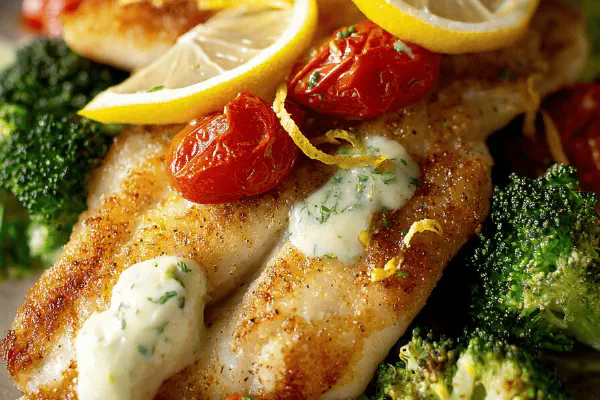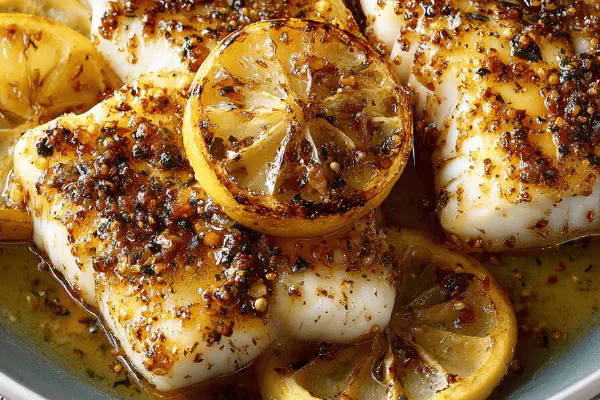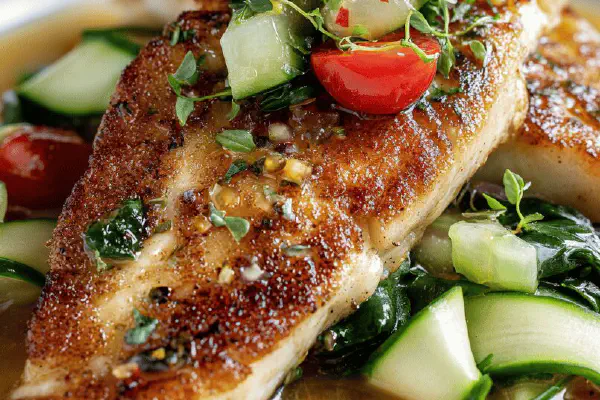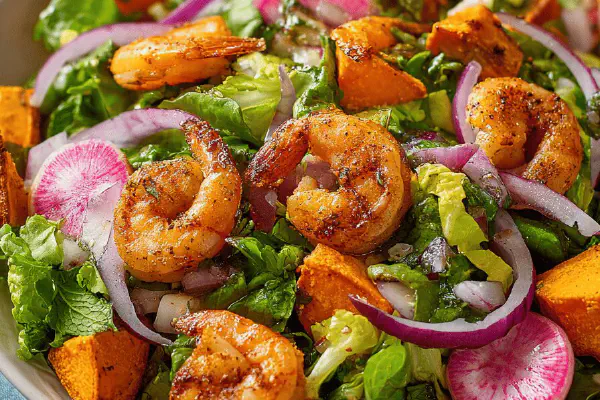Sole Filets with Anchovy Lemon Mayo

By Emma
Certified Culinary Professional
Ingredients
- 65 ml 1/4 cup good-quality mayonnaise
- 12 ml 3 tsp freshly squeezed lemon juice
- 6 ml 1 1/4 tsp anchovy paste
- 2 medium broccolis, stems peeled and cut into florets (reserve stems for broth or soup)
- 70 ml 1/3 cup all-purpose flour, unbleached
- 600 g 1 1/3 lb sole filets, fresh or thawed
- 50 ml 3 1/2 tbsp extra virgin olive oil, divided
- 14 cherry tomatoes, halved (substitute with grape tomatoes based on season)
- 1 lemon, zest finely grated
About the ingredients
Method
- Mix mayo, lemon juice, anchovy paste thoroughly in a small bowl. Adjust anchovy amount if too salty. Chill until serving.
- Set up steamer: place broccolis in perforated steamer basket over simmering water. Cover and steam until just tender but with bite, about 6 minutes. Avoid soggy greens. Drain and set aside.
- While broccoli steams, lightly dust each sole filet with flour. Shake off excess—too much flour clogs pan and dries fish.
- Heat 2 tbsp olive oil in a large nonstick skillet over medium-high heat. When oil shimmers and just starts to move, add filets carefully. Sizzle should sound crisp and lively. Cook fish 1 3/4 to 2 minutes per side until underside is golden brown and edges lift naturally.
- Season lightly with salt and freshly ground pepper. Remove fish to warm plate tented with foil. Resting keeps it moist.
- Use same pan, add remaining 1 1/2 tbsp oil. Toss in steamed broccoli for quick brown. Shifts texture, adds nuttiness. Stir often, 3 to 4 minutes until edges caramelize lightly. If broccoli sticks, add splash of water or turn heat down.
- Arrange broccoli and fish on warmed plates. Spoon thick mayo-anchovy sauce over fish—it should coat but not drown.
- Scatter halved cherry tomatoes over, then zest lemon zest over top for bright aroma and finish.
- Serve immediately, cut lemon wedges on side if more acidity is desired.
- Tips: If no anchovy paste, swap with finely minced olives or capers for briny punch. If mayo too cold and stiff, warm slightly before mixing. Flour fish last minute to avoid sogginess. Watch fish closely; sole cooks fast and flake test indicates doneness better than time.
- Broccoli can be replaced with green beans or asparagus, steamed same way. Tomatoes can be roasted briefly for warmth and sweetness instead of raw.
- Try finishing sauce with a drizzle of olive oil or a pinch of smoked paprika for smoky undertone. Variation depends on mood and pantry.
Cooking tips
Chef's notes
- 💡 Dust sole fillets with flour last second. Too early and moisture ruins crust. Shake off excess flour well. You want light, not a clumpy mess. Flour browns better when unbleached, adds nuttiness. Always use nonstick or well-seasoned pan. Heat oil until it shimmers, listen for sizzle. Crisp sound signals good sear—no oily smell. Flip fish gently when edges lift, not before. Rest fish briefly under foil to keep moist. Skipping rest dries fish quickly.
- 💡 Broccoli timing tricky—steam until just shy of tender. About 6 minutes depending on floret size. Avoid soggy mush; want a bite left. Use a perforated basket for even steam. After steaming, pan-finish broccoli in olive oil for 3-4 minutes, stir often. Light caramelization adds nuttiness and texture. If broccoli sticks or browns too fast, add splash of water or reduce heat immediately. Texture contrast is key: slightly crisp, not limp.
- 💡 Mix mayo, lemon juice, anchovy paste early. Flavors meld better with chill time. Adjust anchovy cautiously; too much kills brightness. If no anchovy paste, crushed olives or capers work but alter taste—less punch, more brine. Mayo should be room temp or slightly warmed if stiff—makes mixing easier, sauce coats better. Avoid drowning fish with sauce; spoon thick layer, it clings without sogging. Lemon zest last step: adds fresh, bright oils. Don’t zest too early or aroma fades.
- 💡 Watch fish close—sole cooks quickly, 1 3/4 to 2 minutes each side depending on thickness. Overcooking makes flakes dry, fibrous. Use feel and sight over timer. Undercooked sole feels slippery, translucent and soft. Flip only when edges lift naturally. Heat olive oil first, let get hot but not smoking. Initial hot oil crisps crust, reduces sticking. Add remaining oil after fish cooks for broccoli to brown, prevents burning and dull flavor.
- 💡 If broccolis not on hand, swap green beans or asparagus steamed same way. Cherry tomatoes can swap for halved olives or lightly roasted mini peppers for sweet warmth. Variations shift balance but keep technique same. Finish sauce with drizzle olive oil or pinch smoked paprika for smoky edge. Keep plates warm or food cools fast. Adjust cook times if fillets vary in thickness by 15 seconds up or down. Visual cues and touch save guessing.
Common questions
How do I avoid soggy fish crust?
Dust fish right before cooking. Too early and moisture seeps in, flour clumps. Shake off excess well. Use unbleached flour browns better. Use hot oil shimmering but not smoking. Crisp sound means pan temp right. Flip only when edges lift—push too early pulls crust off.
Can I replace anchovy paste?
Yes. Crushed olives or capers work as substitutes. They add brine but less umami depth. Anchovy paste gives salty richness that’s hard to match. Adjust mayo and lemon amount after tasting. Keep sauce chilled to meld flavors better. Try small batch first.
Why does broccoli get mushy sometimes?
Usually oversteamed or basket too submerged. Use perforated basket over simmering water, not boiling. Steam until just tender but firm. Pan-sear right after steaming to add crisp texture. Stir frequently to avoid burning. Splash water if sticks. Overcooked broccoli loses crunch, flavor. Timing key.
How to store leftovers?
Separate fish and broccoli if possible. Store in airtight containers. Fish best eaten within 24 hours, broccoli can last 2 days refrigerated. Sauce keep chilled, stir before use. Reheat fish gently in low oven or skillet, avoid microwave or it dries fast. Broccoli can be reheated in skillet too, add splash water if needed. Lemon zest best fresh but ok leftover.



